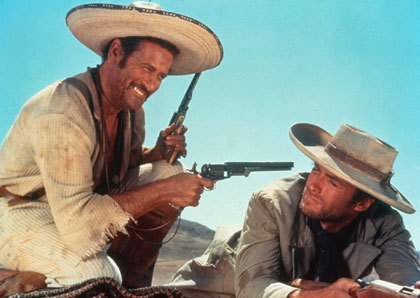« American Splendor (2003) – Movie Review | Home | Lord of the Rings: The Return of the King (2003) – Movie Review »
The Good, the Bad and the Ugly (1966) – Movie Review
By Robert L. Jones | December 10, 2003

Eli Wallach and Clint Eastwood are the West's odd couple in "The Good, the Bad and the Ugly"
Fistful of Leone
[xrr rating=5/5]
The Good, the Bad, and the Ugly. Starring Clint Eastwood, Eli Wallach, Lee Van Cleef, Aldo Giuffre, Luigi Pistilli, Rada Rassimov, Enzo Petito, Molino Rocho, and Mario Brega. Cinematography by Tonino Della Colli. Edited by Eugenio Alabiso and Nino Baragli. Restored version edited by Joe D’Augustine. Sets and costumes by Carlo Simi. Music by Ennio Morricone. Screenplay by Age-Scarpelli, Luciano Vincenzoni, and Sergio Leone. Directed by Sergio Leone. (Metro-Goldwyn-Mayer/United Artists Pictures, 1967 [Restored 2003], Technicolor, 179 minutes. MPAA Rating: R.)
The Good, the Bad and the Ugly is Sergio Leone’s magnum opus. An audacious undertaking, with a totally implausible plot and over-the-top acting, it would have flopped miserably in any other director’s hands. Only someone so committed to his artistic vision as Leone could have pulled off this bombastic pageantry of human nature in all its facets, its capacity for cynicism, greed, bloodlust, revenge, heroism, redemption and honor.
This movie must be experienced. I had seen the DVD of the truncated 1967 version countless times, but I had not seen it on the big screen until this gorgeous restoration I was privileged to watch at Manhattan’s Film Forum. The stereophonic soundtrack of Ennio Morricone’s score pummels you square in the chest from the moment the Lardani titles blast onto the screen in a blaze of Technicolor fury. The montage of color, interspersed by stark black and white visages of Eastwood, Van Cleef and Wallach is a tough act to follow, like Saul Bass’s iconic title sequences.
This MGM/UA print was first restored in Italian by Cineteca Nazionale. The English-language restoration was spearheaded by Martin Scorsese, whose efforts with the Film Preservation Foundation have helped fund preservation of America’s celluloid heritage. Both Eli Wallach and Clint Eastwood returned to the sound studio to dub new dialogue for approximately twenty minutes of restored footage. Both sound a little older and scratchier, but these added scenes help to explain both Tuco’s and Angel Eyes’ gangs and some plot points that were previously unclear. However, they both sound great! (The late Lee Van Cleef’s voice was dubbed by a professional voiceover artist, and actually sounds more on target than the two surviving leads). The movie now has the true feel of a sprawling epic, one that’s earned its right to take its time.
Even though the original was shot silent and then overdubbed in Italian, the English-language version packs the greatest punch, thanks to Mickey Knox, who wrote the English language dialogue. Knox crafted lines that lived up to the larger than life screenplay. You’d swear the original was in English, the dialogue is so perfectly tailored!
But the vision is singularly Leone’s. It starts slowly, as a band of bounty killers home in on their prey, small-time bandit Tuco Benedicto Pacifico Juan-Maria Ramirez (The Ugly, played by the venerable Eli Wallach). They pile through a saloon door, then the camera immediately pans away laterally. Suddenly, his body hurtling through the front window in a rain of glass, Tuco bursts onto the street—in what has to be the most absurd grand entrance in screen history—revolver in one hand, a chicken leg in the other. It’s total chutzpah on Leone’s and Wallach’s part.
If you think that can’t be topped, watch Wallach’s entire performance. Animated is putting it mildly. More than a performance, Wallach is a one-man band, nay, army. Never has such a selfish, petty, ratty and shifty little man been played so larger than life. Wallach smirks, scurries, grimaces, chuckles, shouts, bellows, and slyly oils his way across the screen in what has got to be the hammiest performance ever by a method actor. Or any actor, for that matter: He makes Orson Welles, Burt Lancaster and Charles Laughton look like the gray and sullen cast of an Ingmar Bergman snoozefest. Wallach is so alive with passion that he literally sweats his performance out through the filthy pores on his stubble-ridden face. And he’s wonderful!
If that’s a tough act to follow, you haven’t met The Bad. They don’t come any badder than Angel Eyes, Lee Van Cleef’s hired killer who’s got ice water running through his veins. Van Cleef is ruthless, bold and heartless. Riding out of nowhere onto a doomed man’s rancho, Angel Eyes pays a visit, carrying out a murder for hire. The price: $500. But the victim offers him $1000 to look the other way. No dice: Angel Eyes isn’t in it for the money. Rather, he’s a man who loves his work, and always sees the job through. So, the poor sod dies anyway.
Clint Eastwood is as cool as a cucumber as The Man With No Name (but really one with sort of a name, in this case “Blondie,” which is Wallach’s moniker for him). It’s fun watching the ongoing relationship between Blondie and Tuco as bounty hunter and prey. In another life, they would have been great pals, but in this life (“we’re all alone in this world,” Tuco confesses to Blondie, half seriously, half cynically) their love of money is thicker than friendship. So, they invent ingenious and cruel ways to exact revenge of each other.
It’s during one of Tuco’s sadistic plots—in which he marches pale-faced Eastwood across 100 miles of scorching desert—that the action finally comes to a head: A driverless stagecoach full of wounded Confederates happens across their path, and through a twist of fate, Tuco and Blondie each have two halves of a secret which (if put together) will make them a quarter million dollars richer. But without each other, the two halves are worthless. Thus does Tuco do a 180 from brutal executioner to Blondie’s would-be savior. Now that he could be rich, he suddenly realizes how valuable their friendship is.
It’s not before long that they wind up with Angel Eyes, as they’re captured by Union soldiers. At the prisoner of war camp, a deadly game of cat and mouse begins. Van Cleef is now more restrained and less thuggish as he deals with Tuco to extract the secret; his henchman Wallace (Mario Brega, a Leone stalwart), beats it out of Tuco.
In epic fashion, after a shootout in a deserted town and a bridge demolition that rages across the screen, Tuco, Blondie and Angel Eyes make their way to the cemetery where the treasure is buried. In a fanfare of brass, percussion and chorus, the three face each other down in the cemetery plaza. It’s a gorgeous and cathartic set piece. Credit must go not only to composer Ennio Morricone but also to musical director Bruno Nicolai, who conducts the score con fuoco.
Sergio Leone’s trilogy of Westerns with Eastwood, which began with Fistful of Dollars and For a Few Dollars More, were sneeringly called “Spaghetti Westerns” by skeptical movie reviews when first released. In the 1970s, film theory types renamed them as “revisionist.” But, see this on the big screen for the first time, thirty-seven years after it was shot, and there’s only one label that so perfectly adheres to Il Buono, Il Brutto, Il Cattivo:
“Masterpiece.”
Robert L. Jones is a photojournalist living and working in Minnesota. His work has appeared in Black & White Magazine, Entrepreneur, Hoy! New York, the New York Post, RCA Victor (Japan), Scene in San Antonio, Spirit Magazine (Canada), Top Producer, and the Trenton Times. Mr. Jones is a past entertainment editor of The New Individualist.
Topics: Action Movies, Black Comedies, Classic Movies, Comedies, Dramas, Foreign Films, Movie Reviews, Restored Re-releases, Sequels, War Movies, Westerns | Comments Off on The Good, the Bad and the Ugly (1966) – Movie Review
